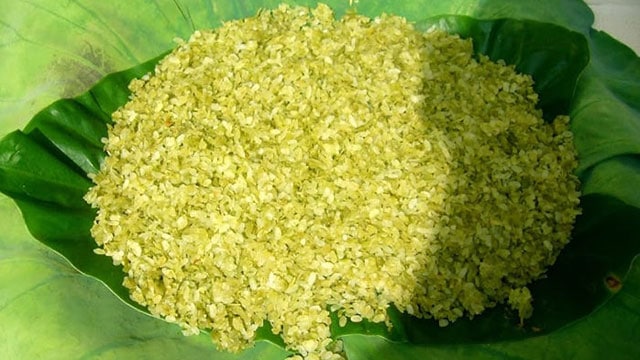The ancient Tu Le region is now famous for its delicious sticky rice. From these heavenly ingredients and delicate hands, they have created many dishes that attract people’s hearts. In the days when people have just rested from work, people invite each other to pound nuggets (com tan). Each beat of the pestle resounded in the night as if dispelling the daily fatigue.
Com Tan Le is considered as delicious as the famous Com Vong village . The still green rice grains, still wet with dew, were carried home by the hand of the reaper.
In order for the nuggets to retain their fresh flavor, they must roast them right after they are finished. You must use a cast iron pan to heat the sticky rice evenly without burning it. Then wait for these cool green pearls to cool, they pound them in handfuls. It takes turns to pound nearly a dozen mortars to get a batch of nuggets.
Tired and burdened like that, but when I see a bunch of green, melted green nuggets in my hand, every beat of the pestle keeps pounding to finish the batch.
To keep the aroma and original greenness of the nuggets, people often wrap them in dong leaves. Tu Le nuggets are used in many different dishes, but there is still a time that does not make people less passionate. This kind of pearl that grows in this land halfway through the sky knows how to win people’s hearts when it is both delicious and fragrant as if it has just been hatched in a bag of incense.
Every August and September every year when the glutinous rice seeds are lying on the side of the Muong Luong stream laden with branches, the season of nuggets has arrived. Each beat of the pestle moves up and down evenly for a fragrant batch of nuggets. The seemingly idyllic pearl from heaven now contributes a little more to create a poetic and charming feature for this Northwest highland.
Source: Collected internet.
According to the ups and downs of the nation's history, Vietnamese customs and practices are constantly being innovated according to social trends. One of the oldest and most influential customs in history is the custom of chewing betel. This is a custom that dates back to the Hung King period and originates from the legend of Trau Areca and this custom has become a typical image of the brotherhood and love between husband and wife of Vietnamese people. Not only the custom of chewing betel, Vietnam also has another custom that was born in ancient times, which is the custom of welcoming the new year, also known as Tet - traditional Tet.
Vietnam - a country winding in an S shape on the East Sea coast, has 54 ethnic groups with resilient, indomitable people, standing tall in the face of many wars of invasion; A country with lands with thousands of years of history. With beautiful natural scenery and precious and abundant natural resources, we - the children of Vietnam - are often proud when talking about our Fatherland, our homeland. Listeners are invited to join VOVLIVE to experience the beauty of the country and
Located on the banks of Ka Long, the border river between Vietnam and China, Xa Tac Temple, Mong Cai City, Quang Ninh Province, is not only a place to worship and practice folk cultural beliefs of residents. This place also has significance as a cultural milestone, affirming the sacred sovereignty of the Fatherland. Recently, this hundreds of years old historical and cultural relic was recognized by the Ministry of Culture, Sports and Tourism as a National relic because of its unique values....
During the resistance war against America to save the country, places in Quang Tri such as: Hien Luong - Ben Hai, Vinh Moc, Con Tien, Doc Mieu, Road 9, Khe Sanh, Ta Con, Cua Viet, Co Citadel... were lost. into national history. When mentioning Quang Tri, many people remember the Quang Tri Ancient Citadel with its fierce battle that lasted for 81 days and nights. Therefore, peace is always the burning desire of the people of Quang Tri province as well as of all Vietnamese people. The desire for peace is also the wish of tens of thousands.
